| |
Lopinavir/Ritonavir (LPV/r) Combined With Raltegravir (RAL) Provides More Rapid
Viral Decline Than LPV/r Combined With Tenofovir Disoproxil Fumarate/Emtricitabine
(TDF/FTC) in Treatment-naïve HIV-1 Infected Subjects
|
| |
| |
Reported by Jules Levin
Thomas Podsadecki, M.D., Min Tian, M.S., Linda Fredrick, M.S., Adebayo Lawal, M.D., Barry Bernstein, M.D.
Abbott Laboratories, Abbott Park, IL, USA
Corresponding author: Thomas Podsadecki; Abbott Laboratories, 200 Abbott Park Road, Dept. R48U, AP-30, Abbott Park, IL 60064, thomas.podsadecki@abbott.com
15th Annual Conference of the British HIV Association (BHIVA) • 1-3 April 2009 • Liverpool, UK
SUMMARY
• Subjects in the LPV/r + RAL group were more likely to have HIV-1 RNA levels below the limit of quantifi cation (<40 copies/mL) at 2, 4, and 8 weeks of treatment compared with subjects administered LPV/r + TDF/FTC.
- The rapid viral suppression observed for LPV/r + RAL is consistent with a previous study in which RAL was administered with NRTIs.3
- The response to LPV/r + TDF/FTC mirrors that seen in a previous trial,14 suggesting that the results observed here are not simply due to underperformance of the control arm.
• While the mean increase in CD4+ T-cell count was numerically greater for LPV/r administered with RAL versus NRTIs, there was no statistically signifi cant difference in immune recovery between treatment groups through week 8.
• LPV/r + RAL was safe and well-tolerated, with diarrhea being the most commonly-reported adverse event in both treatment arms.
- Moderate-to-severe, drug-related diarrhea occurred in 4.0% of subjects in the LPV/r + RAL group group and 8.6% of subjects taking LPV/r + TDF/FTC.
- Elevations in triglycerides, total cholesterol, and HDL cholesterol were greater in the LPV/r + RAL treatment group; however, only a small number of subjects in either treatment group experienced Grade 3 or greater elevations in these parameters.
CONCLUSIONS
• Through 8 weeks of treatment, an NRTI-sparing dual-agent regimen of LPV/r + RAL is well tolerated and enabled a greater proportion of antiretroviral-naïve, HIV-1-infected individuals to achieve viral loads <40 copies/mL compared with LPV/r + TDF/FTC.
BACKGROUND
Lopinavir/ritonavir
• Lopinavir (LPV) is an HIV-1 protease inhibitor (PI) that is co-formulated with ritonavir (r), which functions as a pharmacokinetic enhancer.
• Durable antiviral activity of LPV/r has been demonstrated in antiretroviral-naïve and PI-experienced patients.1, 2
Raltegravir
• Raltegravir (RAL) is an inhibitor of the HIV-1 integrase with potent antiviral activity.
- In combination with 2 nucleoside reverse transcriptase inhibitors (NRTIs), RAL results in more rapid viral decline than efavirenz + 2 NRTIs in treatment-naïve patients over the fi rst 8 weeks of treatment.3
- Results of a Phase III randomized clinical trial demonstrate rapid and sustained suppression of HIV-1 RNA levels in treatment-naïve subjects through 48 weeks with RAL + TDF and lamivudine.4
- RAL provides enhanced antiviral activity when added to an optimized background regimen in treatment-experienced patients.5
Treatment Simplification
• In many HIV-infected patients, initiating a regimen that spares the use of NRTIs may be desirable to achieve a reduced pill burden and avoid NRTI-associated toxicity.
• Clinical trials have demonstrated that dual-agent NRTI-sparing regimens can produce similar response rates to standard combination therapy in antiretroviral-naïve subjects.6, 7, 8
• The availability of newer classes of antiretroviral drugs (i.e. integrase inhibitors) offers additional options for NRTI-sparing treatment regimens. HIV-1 RNA Dynamics
• Decay of HIV-1 RNA in response to antiretroviral therapy is biphasic.
- The first phase occurs within the initial week of treatment and represents clearance of activated, virus-producing CD4+ T-cells.9
- A second, sustained phase is thought to represent elimination of other longer-lived cellular compartments.9
• Rapid viral decay is associated with improved therapeutic outcomes.
- Faster viral suppression may minimize the development of resistance.10
- Virus levels at weeks 4 and 8 are indicative of treatment response at weeks 24 and 48, and are superior to pretreatment RNA levels as predictors of response.11, 12
OBJECTIVES
• Study M10-336 was designed to compare the safety, tolerability and antiviral activity of an NRTI-sparing regimen of LPV/r + RAL to LPV/r + TDF/FTC.
• This analysis explores the differences between treatment groups in viral decay through week 8.
METHODS
• Study M10-336 is an ongoing Phase III, open-label, randomized study.
• The primary endpoint is to compare the antiviral effi cacy of LPV/r + RAL and LPV/r + TDF/FTC after 48 weeks of treatment.
Study Design
• Following screening, subjects were randomized 1:1 to LPV/r + RAL or LPV/r + TDF/FTC (Figure 1).
• LPV/r tablets were administered at 400/100 mg BID with either the integrase inhibitor RAL (400 mg BID) or fi xed-dose NRTI combination tablets of TDF/FTC (300/200 mg QD).
Study Population
• Inclusion criteria:
- HIV-1-infected adults at least 18 years of age providing informed consent
- naïve to antiretroviral treatment
- plasma HIV-1 RNA ≥1,000 copies/mL
- any CD4+ T-cell count
• Exclusion criteria:
- genotyping at screening indicated resistance to LPV/r, TDF, or FTC
- history of allergy or sensitivity to LPV/r, TDF/FTC, or RAL
- history of medical or psychiatric illness that would interfere with adherence to the protocol
- hemoglobin ≦8.0 g/dL, absolute neutrophil count ≦750 cells/_L, platelet count ≦50,000/mL, ALT (SGPT) or AST (SGOT) ≥3.0X Upper Limit of Normal (ULN), calculated creatinine clearance <50 mL/min, or positive for Hepatitis B surface antigen

Efficacy Analysis
• The proportion of subjects with HIV-1 RNA levels below the limit of quantifi cation (<40 copies/mL) based on on-treatment analysis at weeks 2, 4, and 8 was compared between treatment groups using Fisher's exact test.
• The mean change from baseline to weeks 4 and 8 in CD4+ T-cell count was analyzed using one-way ANOVA with treatment group as the factor.
Safety Analysis
• The proportion of subjects reporting treatment-emergent adverse events (AEs) through week 8 was compared between treatment groups using Fisher's exact test.
• The incidence of Grade 3+ laboratory abnormalities (according to NIAID Division of AIDS Adverse Event Grading13) was compared between treatment groups using Fisher's exact test.
• Mean changes in lipid parameters and chemistry values from baseline to weeks 4 and 8 were compared between treatment groups using one-way ANOVA with treatment group as the factor.
RESULTS
• The study randomized 209 subjects.
- 3 subjects were randomized but not dosed.
- 101 subjects received LPV/r + RAL.
- 105 subjects were administered LPV/r + TDF/FTC.
• Through week 8, a total of 3 subjects from the LPV/r + TDF/FTC treatment group discontinued prematurely: 2 withdrew consent, and 1 subject discontinued due to pregnancy. There were no discontinuations through week 8 for subjects in the LPV/r + RAL arm.
• Subjects' baseline demographic and disease characteristics were similar between groups and are displayed in Table 1.
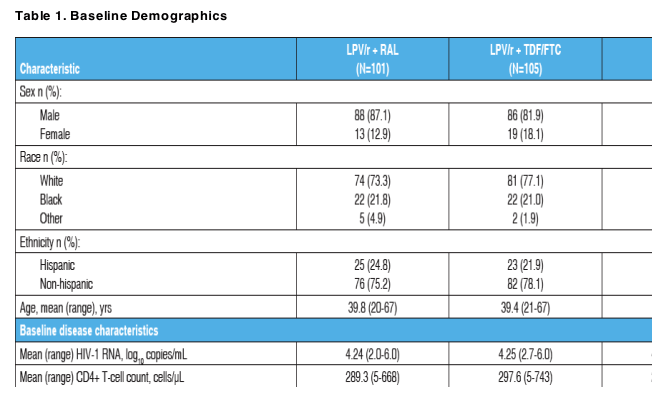
Virologic Efficacy
• By observed data analysis, statistically signifi cantly greater
proportions of subjects had HIV-1 RNA levels <40 copies/
mL at weeks 2, 4, and 8 when treated with LPV/r + RAL
compared with LPV/r + TDF/FTC (Figure 2).
- At week 8, nearly twice as many subjects receiving
RAL achieved viral suppression below the limit of
quantifi cation compared with those receiving NRTIs
(p<0.001).
- Through week 8, on-treatment results are consistent
with outcomes using intent-to-treat analysis.
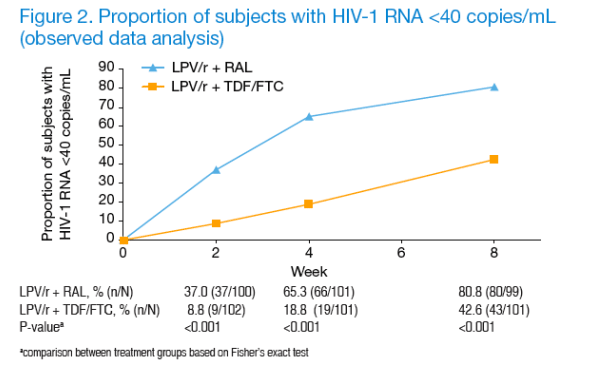
Immunologic Efficacy
• Both treatment groups had statistically significant mean
increases in CD4+ T-cell count from baseline to weeks 4
and 8 (p<0.001 for both).
• While mean increases in CD4+ T-cell count from baseline
to week 4 or 8 were numerically greater for LPV/r + RAL
compared to LPV/r + TDF/FTC, the differences between
groups were not statistically significant (Figure 3).
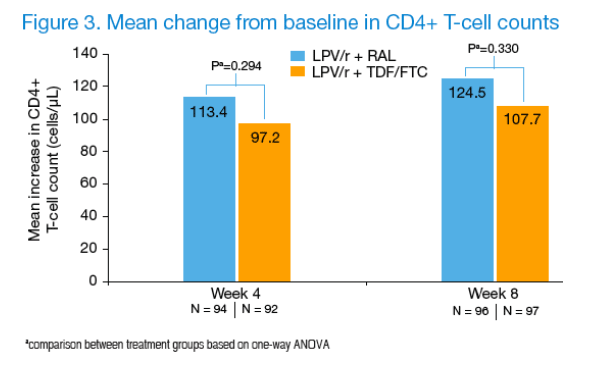
Safety Analysis
• Overall, the incidences of treatment-emergent AEs were not different between treatment groups.
- The most commonly-reported events occurring in ≥10% of subjects, regardless of severity or relationship to study drug, were gastrointestinal in nature, including diarrhea, nausea, and fl atulence. Headache was also commonly reported and did not differ between groups.
• Moderate-to-severe, study drug-related AEs were also similar between groups.
- Diarrhea, which occurred in 4.0% (4/101) of LPV/r + RAL subjects and 8.6% (9/105) of subjects taking LPV/r + TDF/FTC, was the only event occurring in ≥5.0% of subjects in either treatment arm. This difference was not statistically signifi cant.
• Clinically signifi cant laboratory abnormalities were infrequent.
- Incidence of Grade 3+ laboratory abnormalities13 occurring in ≥5.0% of either treatment arm:
- The proportion of subjects showing cholesterol elevations (>7.77 mmol/L [>300 mg/dL]) was not statistically signifi cantly different between groups; elevations occurred in 6.9% (7/101) of LPV/r + RAL subjects and 2.9% (3/102) of LPV/r + TDF/FTC subjects (p>0.100).
- The proportion of subjects showing triglyceride elevations (>8.475 mmol/L [>750 mg/dL]) was statistically signifi cantly different between groups; elevations occurred in 5.9% (6/101) of LPV/r + RAL subjects, but were not observed in LPV/r + TDF/FTC subjects (p=0.014).
• Lipid analysis
- Mean changes in lipid levels from baseline to week 8 were statistically significantly greater for triglycerides, total cholesterol, and HDL cholesterol in the LPV/r + RAL arm, but not signifi cantly different between treatment groups for LDL cholesterol and the HDL:LDL ratio (Table 2).
• Changes in laboratory chemistry values
- From baseline to week 8, mean changes in chemistry values were statistically signifi cantly different between the LPV/r + RAL and LPV/r + TDF/FTC groups for creatinine, BUN, sodium, magnesium, and alkaline phosphatase (Table 3).
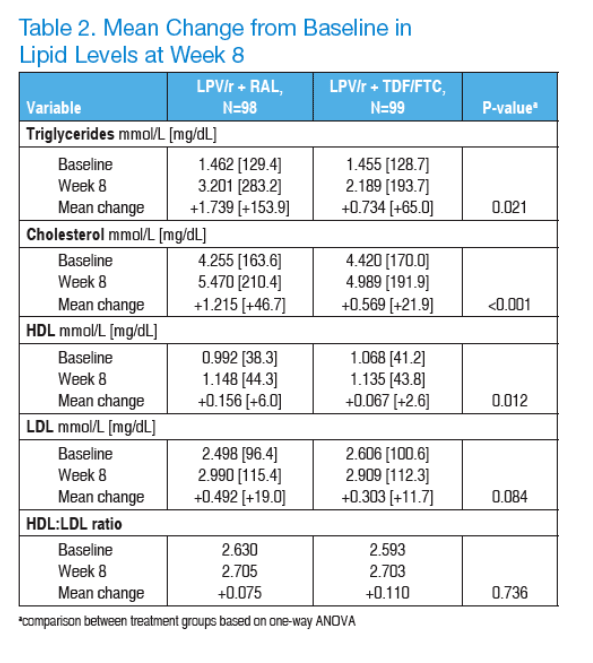
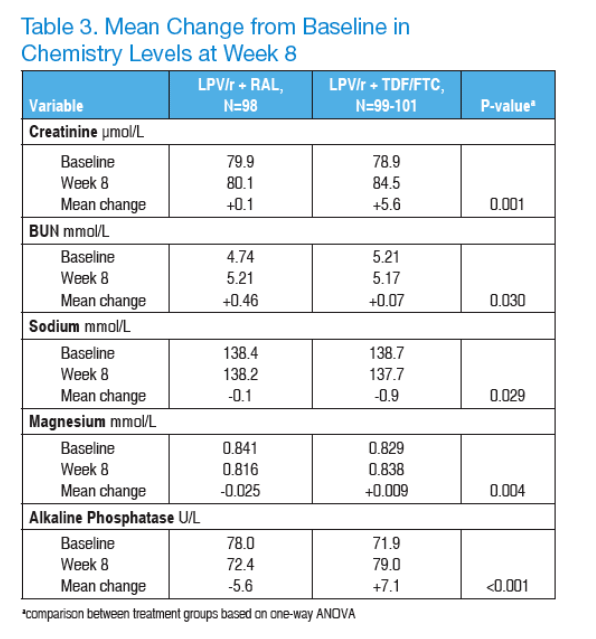
REFERENCES
1. Murphy R., da Silva B. A., Hicks C. B., et al. Seven-Year Effi cacy of a Lopinavir/Ritonavir-Based Regimen in Antiretroviral-Naïve HIV-1-Infected Patients. HIV Clin Trials. 2008, 9:1-10.
2. Bongiovanni M., Bini T., Capetti A., et al. Long-term antiretroviral effi cacy and safety of lopinavir/ritonavir HAART-experienced subjects: 4 year follow-up study. AIDS. 2005, 19:1934-6.
3. Murray J. M., Emery S., Kelleher A. D., et al. Antiretroviral therapy with the integrase inhibitor raltegravir alters decay kinetics of HIV, signifi cantly reducing the second phase. AIDS. 2007, 21:2315-21.
4. Lennox J., DeJesus E., Lazzarin A., et al. STARTMRK, A Phase III Study of the Safety & Effi cacy of Raltegravir (RAL)-based vs Efavirenz (EFV)-based Combination Therapy in Treatment-Naïve HIV-Infected Patients [abstract # LB H896A]. 48th Annual ICAAC/46th Annual IDSA, Washington D.C., October 25-28, 2008.
5. Grinsztejn B., Nguyen B. Y., Katlama C., et al. Safety and effi cacy of the HIV-1 integrase inhibitor raltegravir (MK-0518) in treatment-experienced patients with multidrug-resistant virus: a phase II randomised controlled trial. Lancet. 2007, 369:1261-9.
6. Negredo E., Molto J., Burger D., et al. Lopinavir/ritonavir plus nevirapine as a nucleoside-sparing approach in antiretroviral-experienced patients (NEKA study). J Acquir Immune Defi c Syndr. 2005, 38:47-52.
7. Duvivier C., Ghosn J., Assoumou L., et al. Initial therapy with nucleoside reverse transcriptase inhibitor-containing regimens is more effective than with regimens that spare them with no difference in short-term fat distribution: Hippocampe-ANRS 121 Trial. J Antimicrob Chemother. 2008, 62:797-808.
8. Riddler S. A., Haubrich R., DiRienzo A. G., et al. Class-sparing regimens for initial treatment of HIV-1 infection. N Engl J Med. 2008, 358:2095-106.
9. Perelson A. S., Essunger P., Cao Y., et al. Decay characteristics of HIV-1-infected compartments during combination therapy. Nature. 1997, 387:188-91.
10. Metzner K. J., Allers K., Rauch P., et al. Rapid selection of drug-resistant HIV-1 during the fi rst months of suppressive ART in treatment-naive patients. AIDS. 2007, 21:703-11.
11. Powderly W. G., Saag M. S., Chapman S., et al. Predictors of optimal virological response to potent antiretroviral therapy. AIDS. 1999, 13:1873-80.
12. Lepri A. C., Miller V., Phillips A. N., et al. The virological response to highly active antiretroviral therapy over the fi rst 24 weeks of therapy according to the pre-therapy viral load and the weeks 4-8 viral load. AIDS. 2001, 15:47-54.
13. Regulatory Compliance Center. Division of AIDS Table for Grading the Severity of Adult and Pediatric Adverse Events, December 2004. National Institute of Allergy and Infectious Diseases. Available at: http://rcc.tech-res.com/DAIDS%20RCC%20Forms/ToxicityTables_DAIDS_AE_GradingTable_FinalDec2004.pdf.
14. Gathe J., Silva B. A., Cohen D. E., et al. A Once-Daily Lopinavir/Ritonavir-Based Regimen Is Noninferior to Twice-Daily Dosing and Results in Similar Safety and Tolerability in Antiretroviral-Naive Subjects Through 48 Weeks. J Acquir Immune Defi c Syndr. 2009, in press
|
|
| |
| |
|
|
|